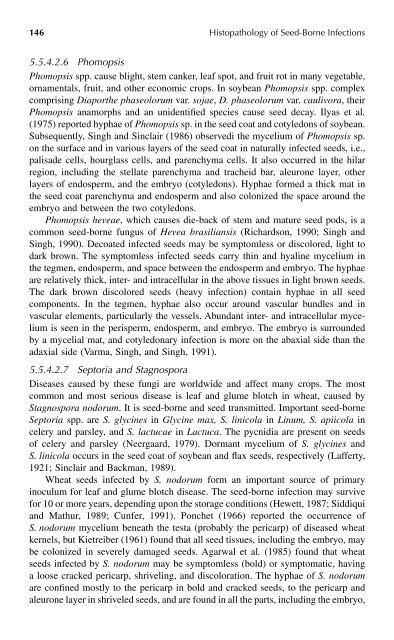Histopathology of Seed-Borne Infections - Applied Research Center ...
Histopathology of Seed-Borne Infections - Applied Research Center ...
Histopathology of Seed-Borne Infections - Applied Research Center ...
You also want an ePaper? Increase the reach of your titles
YUMPU automatically turns print PDFs into web optimized ePapers that Google loves.
146 <strong>Histopathology</strong> <strong>of</strong> <strong>Seed</strong>-<strong>Borne</strong> <strong>Infections</strong>5.5.4.2.6 PhomopsisPhomopsis spp. cause blight, stem canker, leaf spot, and fruit rot in many vegetable,ornamentals, fruit, and other economic crops. In soybean Phomopsis spp. complexcomprising Diaporthe phaseolorum var. sojae, D. phaseolorum var. caulivora, theirPhomopsis anamorphs and an unidentified species cause seed decay. Ilyas et al.(1975) reported hyphae <strong>of</strong> Phomopsis sp. in the seed coat and cotyledons <strong>of</strong> soybean.Subsequently, Singh and Sinclair (1986) observedi the mycelium <strong>of</strong> Phomopsis sp.on the surface and in various layers <strong>of</strong> the seed coat in naturally infected seeds, i.e.,palisade cells, hourglass cells, and parenchyma cells. It also occurred in the hilarregion, including the stellate parenchyma and tracheid bar, aleurone layer, otherlayers <strong>of</strong> endosperm, and the embryo (cotyledons). Hyphae formed a thick mat inthe seed coat parenchyma and endosperm and also colonized the space around theembryo and between the two cotyledons.Phomopsis heveae, which causes die-back <strong>of</strong> stem and mature seed pods, is acommon seed-borne fungus <strong>of</strong> Hevea brasiliansis (Richardson, 1990; Singh andSingh, 1990). Decoated infected seeds may be symptomless or discolored, light todark brown. The symptomless infected seeds carry thin and hyaline mycelium inthe tegmen, endosperm, and space between the endosperm and embryo. The hyphaeare relatively thick, inter- and intracellular in the above tissues in light brown seeds.The dark brown discolored seeds (heavy infection) contain hyphae in all seedcomponents. In the tegmen, hyphae also occur around vascular bundles and invascular elements, particularly the vessels. Abundant inter- and intracellular myceliumis seen in the perisperm, endosperm, and embryo. The embryo is surroundedby a mycelial mat, and cotyledonary infection is more on the abaxial side than theadaxial side (Varma, Singh, and Singh, 1991).5.5.4.2.7 Septoria and StagnosporaDiseases caused by these fungi are worldwide and affect many crops. The mostcommon and most serious disease is leaf and glume blotch in wheat, caused byStagnospora nodorum. It is seed-borne and seed transmitted. Important seed-borneSeptoria spp. are S. glycines in Glycine max, S. linicola in Linum, S. apiicola incelery and parsley, and S. lactucae in Lactuca. The pycnidia are present on seeds<strong>of</strong> celery and parsley (Neergaard, 1979). Dormant mycelium <strong>of</strong> S. glycines andS. linicola occurs in the seed coat <strong>of</strong> soybean and flax seeds, respectively (Lafferty,1921; Sinclair and Backman, 1989).Wheat seeds infected by S. nodorum form an important source <strong>of</strong> primaryinoculum for leaf and glume blotch disease. The seed-borne infection may survivefor 10 or more years, depending upon the storage conditions (Hewett, 1987; Siddiquiand Mathur, 1989; Cunfer, 1991). Ponchet (1966) reported the occurrence <strong>of</strong>S. nodorum mycelium beneath the testa (probably the pericarp) <strong>of</strong> diseased wheatkernels, but Kietreiber (1961) found that all seed tissues, including the embryo, maybe colonized in severely damaged seeds. Agarwal et al. (1985) found that wheatseeds infected by S. nodorum may be symptomless (bold) or symptomatic, havinga loose cracked pericarp, shriveling, and discoloration. The hyphae <strong>of</strong> S. nodorumare confined mostly to the pericarp in bold and cracked seeds, to the pericarp andaleurone layer in shriveled seeds, and are found in all the parts, including the embryo,


